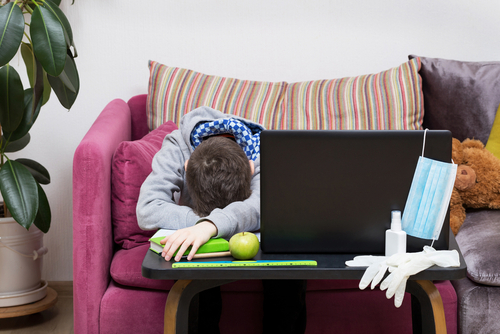14 min read
Have the benefits of remote working started to wane? If so, do you feel like you are now living at work?
There are many plusses to working from home, but stepping away from our desk and switching off is hard when our work and personal space are one and the same.
Read my top 20 tips on protecting your well-being as we continue to work from home. From simple steps to handy hacks, make remote working work for you with my 4 step plan for healthy homeworking.
I hope they help.
Stay safe and stay well.
The 4 Step plan for healthy homeworking.
There are some key areas to consider when making remote working work for you. The first is to establish clear boundaries between work and home life and a healthy work routine. Then there’s your work space and office ergonomics, taking care of your posture. Looking after your wider mental and physical health is a key consideration too, which is even more important under Covid. Finally, creating a good work life balance by making sure you relax and wind down in the evening comes into its own. This then enables us to switch off and get a good night’s sleep which in turn sets up both increased productivity in our daily work and long-term wellness.
Step 1 Build the perfect work routine.
Everyone is different so the ‘perfect work routine’ is the one which works for you. A good place to start is to look at what worked for you when you were based in the office. There are a number of principles which also help structure both a productive and healthy working day.
Get dressed for work.
Don’t stay working in your pj’s. Instead, take and shower or have a bath and get dressed for work. Research on the impact on clothes on behaviour has shown that the clothes we wear affect our behaviour, attitudes, personality, mood and confidence. This is called Enclothed Cognition .In the evening, if you would normally get changed into more casual clothes, do the same when homeworking. This can help you more fully relax. ‘We are what we wear’.
Recreate the transitions of commute.
Whilst the commute to and from work cost both time and money, it also creates a useful transition period. In the morning it allowed us to plan the day ahead. If you used the bus, train or tube to commute, you also had the option of catching up on the news or reading a book. Then after work, the evening commute offered the opportunity to review the workday, to wind down and to leave work stress out of home. If you are working at home, try to recreate these transitions and boundaries between home and work, and work and home. In the morning you could pop out for get a take-away coffee and then come back home to work. If you wound down and ‘reconnected with yourself’ during the commute home recreate this space too. Why not have a 15- minute walk around the block at the end of the day before starting your evening with your family or friends?
Get out of your chair at least once an hour.
Build a work schedule which supports your mental and physical health. Make sure you take regular breaks to re-energise your mind and body and give your spine and muscles a break from a fixed posture. Our body is designed to move, not stay stuck in a seated posture for long periods, nor our mind switched on. Research has shown that short breaks throughout the day are more beneficial than less frequent longer breaks. One routine for time management when home working, called the Pomodoro Technique splits your work into short 25 minute bursts, followed by a five minute break. I recommend that you work at a computer or desk no longer than 50 minutes at a time. So, if you tend to have back to back hour long meetings on Zoom, finish them earlier. Then take a 10-minute break where you can stretch out and ‘de-stress’ and focus on something other than work for a few minutes.
Get outside daily too
Make sure you have a lunch hour, or at least a ½ hour break. Go outside, take some exercise, get fresh air, sunlight and a dose of Vitamin D. All of this will help you sleep better. Getting outside also provides a different perspective, often undoing mental blocks. At the weekend include a walk in the park or country with the family. This gets you away from technology and re-energises your mind, body and spirit.
Take your calls on a walk.
Rather than rely on email chains take the opportunity to call a colleague when you can. A conversation can often be more productive and is certainly more simulating and social. Also, if you have calls that are due make which could be done without a screen, do them whilst out on a walk. Pick a route that is quiet so you will not be distracted.
Socialise with colleagues
For many being part of team, sitting near colleagues you can bounce ideas off, and the more social ‘corridor talk’ is a natural part of work-life which is now missing through home-working. In fact, in a recent poll of office workers now remote working 62% stated that they missed chatting to co-workers. Having a zoom call for a chat with workmates will help. Or, even better, meet in a socially distant way once a week or so. If you don’t have work colleagues, you could join an online group.
Manage your children’s schedule too.
Homeworking perhaps becomes the most challenging for those with young children especially those with children at home. If you have little ones in the house schedule key work in nap times. With older children, agree times that you are available for playing. At the same time agree times for answering questions with partners too. If you are involved in the school run carry on doing this keeping the family’s routine as close to normal as possible. This will help reduce the stress of change.
Use do not disturb.
When you were in the office, a closed door would often be an indicator that you were unavailable. If you want to remain uninterrupted when home-working let your co-workers / contacts know this by switching your social media and apps to busy or do not disturb. Team chat programmes such as HipChat or Slack have a ‘Do not disturb’ function.
Keep everyone in the loop.
If you aren’t in a structured week with lots of zoom meetings and social chats, it’s very easy to fall out of the loop when remote working. Reach out to co-workers and managers regularly through all the available channels such as email, phone and video calling. Aim at keeping up to speed in the same manner you would expect when based in the office, but also be mindful of overcommunicating.
Step 2 – Invest in a home-office fit for work.
Invest time and money to create the best possible work environment at home. This will not only protect your back and neck, but also enable you to work more efficiently.
Keep work and home separate.
Always keep your work and home/relaxation/sleep space as separate and as distinct as possible. Create a space in your home which is dedicated to work, and never work in your bedroom. Equally avoid working on your couch as your brain will start to associate this personal environment with work and make it far harder to relax later. I recommend keeping your home office as close to that which you normally work from as possible to recreate a focus on work not home. Thus, if you don’t have fragrant oil burners, or music on in the office, don’t add them to your home office when you are remote working. However, if the noise in the house or outside disturbs your concentration is could be worth considering using a white noise machine to mask the sounds. Make your office as comfortable and as professional as possible and try to get natural light into your workspace too. Natural light is proven to increase productivity. For those who feel a bit lower in the darker winter months you could even consider using a SAD lamp near your computer in the mornings. If you are considering working at home long term you could also adapting your home on a more permanent basis to create a bespoke work space Finally, at the end of the day always switch off your computer and tidy away papers and work items.
Look after your back and neck.
It’s more than likely that you will be sitting for longer so take time to make sure your home-office is as ergonomic as possible. The aim here is to support each area of your body and keep your spine in a neutral alignment. Your head should be above the rest of the spine, eyes looking straight ahead at the screen. Your elbows should be at 90 degrees to keep your shoulders as relaxed as possible. Use a support for your wrist(s) too, to ease them as you use your mouse. If you are using a laptop for work, it’s important to buy a proper monitor to plug in. Without this you will be looking down and straining your neck muscles. Your monitor should be placed roughly at arm’s length in front of you and at an angle of 15 degrees with the top of the screen ideally at eye level.
Invest in a good chair.
If you have the option of setting up a new home office from scratch, look for a good chair which allows you to recline with a ‘synchronous tilt’. This can help relieve the pressure on your back. Ideally this chair should have adjustable and removable arm rests. A good curved lumbar support is key too. Use a small pillow in the lumbar area of your back if your chair doesn’t have this. The seat of your chair should have a 1 to 2-inch gap between the inside of your knees and the edge of the chair. For those with long term lower back issues, and the space and money for a dedicated home office, a ‘sit-stand-workstation is also worth considering. Here you can raise or lower your work surface to alternate between sitting and standing.
Step 3 – Don’t forget to look after your health.
With all the stress of the changes to work and family routines healthy habits often get forgotten. Also, whilst the saved commute time is a bonus for those new to home working, many find it more stressful than working in the office. Certainly, at the start of lockdown, new home-centred workers reported a greater fall in mental health than established home-centred workers. Whilst home working has now become more familiar, over 40% of homeworkers are working longer hours than they would have done in the office. This often leaves less time for leisure and exercise. Along with the reduced socialising from lockdown, and the temptation to eat less healthily in the gloomier winter days, this all affects both our mental and physical health. Not great for wellness when we need to be at peak health to combat Covid.
Take Vitamin D
It’s now recommended that we take Vitamin D supplements during the darker months from October to March, especially if we aren’t going outside. This is due to the reduced sunlight. Eating a diet with fatty fish will help boost Vitamin D too. Apart for being needed for your joints and bones, Vitamin D helps to supports your mental wellbeing, a healthy immune system and a good nights’ sleep. There’s also evidence from studies done in Spain that for those admitted to hospital with Covid-19 the symptoms are reduced.
Eat and drink healthily.
The gloomier winter days can often lead to eating ‘comfort food’. This sort of sugary; stodgy and often processed food, is proven to both disrupt our sleep, and increase our weight. With the latter being a risk factor for Covid-19 it’s more important than ever to eat healthily. Aim at eating a ‘Mediterranean diet’ consisting of fresh fruit and vegetables, fish, seeds and nuts and some meat. These fresh foods supply the nutrients needed to boost our immune system too. Alcohol consumption is also something to consider for weight and sleep. Whilst the sedative affect alcohol helps us get to sleep, alcohol then disrupts our sleep later in the night. Try to limit yourself to two drinks at night, and to stop drinking booze two hours before bedtime.
Keep connected with friends and family.
Make sure meet your friends and family in person ( one on one outside in lockdown) on a regular basis rather than a facetime or zoom call. Whilst video calls are more social than phone calls, online face to face contact isn’t ‘natural’. Lack of human contact is known to get us down, so make time to socialise (distantly and safely) in person. Also, why not take the opportunity to make home working work for you. Go out for lunch with your partner or family. Or contact an old friend and meet up.
Find new ways to exercise.
We all know that exercise is good for our mind and bodies, but it’s also now proven that exercise also helps us to sleep better. Covid Lockdown and working from home has changed lots of exercise routines, not least with reducing visits to the gym. Why not go outside for a run or bike ride first thing to get your daily dose of vitamin D. A weekend run or fast walk would be a great addition too. The recommendation from the UK’s Chief Medical Officer (CMO) is that every week we get at least 150 minutes (2 1/2 hours) of moderate intensity activity (such as brisk walking or cycling); or 75 minutes of vigorous intensity activity (such as running. Or you can have a mix of the two. If you are finding it harder to switch off and get to sleep, or suffer from an achy back or neck, a nightly home yoga routine could be useful. Ideally you should avoid exercising late at night however, as the rise in body temperature close to bedtime can keep you awake.
Address the stress and get more sleep.
All of us will have experienced the decrease in concentration and focus we get after a poor night’s sleep. Equally, the short and long-term effects of reduced sleep on our mental and physical wellbeing are now well documented. In fact, a good night’s sleep is required for the health of virtually all of our internal systems including our Immune System. With the saved time of our commute in theory we have more time to sleep if needed. However, surveys undertaken during lockdown highlighted that 2/3rds of us were getting poorer sleep (link to post), with increased stress the main reason. If you find it hard to switch off your mind at night, I have some relaxation and meditation technique. You could also try downloading one of the many ‘Mindfulness and Relaxation Apps.
Step 4- Relax and wind down in the evening.
A lot of us fall into the trap of blurring boundaries between work and home both in terms of time and space when remote working. We often have to compromise when we are short of rooms to create a dedicated office. However, as long as we focus on ergonomics and healthy work routines most of us are able to accommodate a less than perfect remote working environment. However, as we are essentially living at work it’s easy to carry on working into the evening to hit deadlines, rather than using our saved commute time for leisure and relaxation. Of those who were working longer hours 20% then reported that they were finding it harder to switch off.
Have a healthy evening routine.
The key here is to set clear boundaries about when you begin and finish work. Agree start and end times with bosses, clients and colleagues and avoid responding to emails, texts or calls outside of these ‘home-office-hours’ . If you have trouble sleeping, make sure you stop all tech at least an hour before bed. It’s well known that tech and sleep don’t go together. Stopping caffeine after lunch is important too, so is having a healthy evening and sleep routine including baths, books, yoga, relaxation and meditation, a tech free bed and regular sleep and wake times.
Switch-off off-screen.
For many remote working means hours looking at a screen. Whilst watching TV in the evening switches us off from work it is yet another screen. Equally lots of us now engage in playing games online after work to unwind. Why not mix these pass-times with ‘real games’ such as board games, cards, chess and scrabble etc? These are more physically engaging and great for connecting with family or with partners. Also, if you feel adrenalized after your work, try to stay offline rather than go back online. It’s important to try to minimise online screen time in the evening. This will help you to feel more ‘in your body rather than ‘in your head’.
Take a ‘time-out’ or engage in a hobby.
I often recommend to clients who find it hard to switch off in the evening that they find ½ hour to reflect on their day in peace and quiet, then plan a to do list for the next day. This can then include a short meditation exercise if they prefer to help them relax. Alternatively, you could re-engage a hobby you had as a child. Doing a jigsaw was one of my favourites. Find something that gets ‘you out of yourself’ and in the flow. The American Psychologist Martin Seligman refers to this state as the loss of self-consciousness during an absorbing activity. According to Seligman when we are in the flow, we ‘merge with the object and use up all the cognitive and emotional resources that make up thought and feeling’. This is one of the best ways to switch off and relax after a day home working on the computer.
So what next for remote working? Certainly working from home is here to stay. According to a YouGov survey 40% of those who had never worked at home before Covid-19 now say they want to be able to do so once the crisis is over. However, in a recent survey of office workers conducted by Morgan Stanley most workers who wish to continue working from home stated that they would want to split their time between home and office. The preference was to spend one or two days a week working remotely. Just 17% wanted to stay at home full-time.
The social aspect of working in the office is the biggest draw here versus the isolation of home-working. The biggest single thing workers are looking forward to about an eventual return to the office is camaraderie
It would certainly seem the biggest challenge of home-working, especially in the new-covid world, for both companies and workers is mental rather than physical with human contact at the fore.
If you would like one to one help with any aspect of home working please get in touch at dave@thesleepsite.live-website.com. Also, I would love feedback on how these tips worked for you and if you have any of your own please feel free to share more ideas too.









